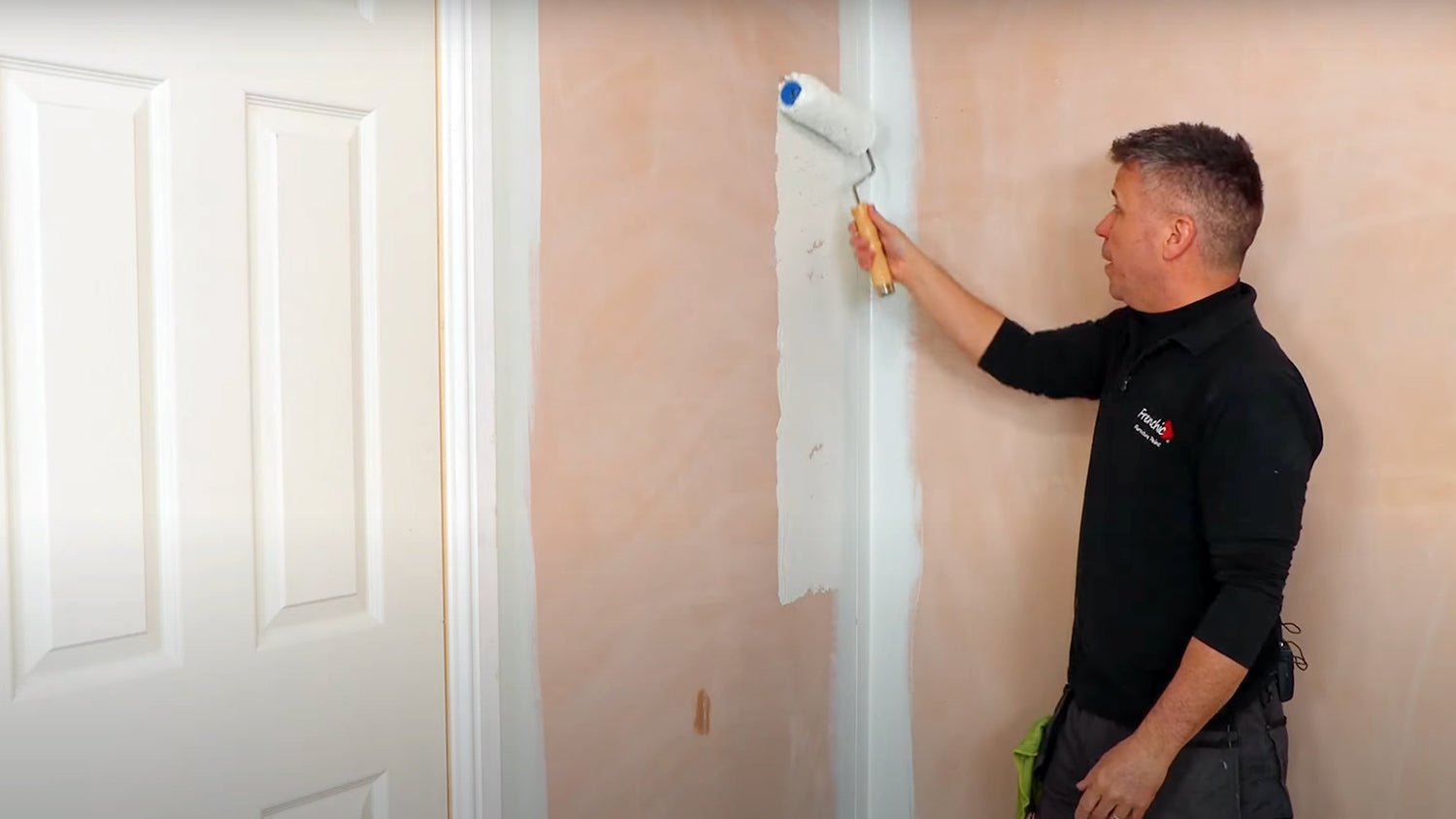Without the right care and attention, paint on new plaster can become flaky or uneven. Read on as we briefly discuss drying times, preparation and mist coats when painting new plaster. Or check out our video on how to paint new plaster walls:
Let your plaster dry fully
Before considering how to paint new plaster, ensure your plaster is completely dry. This is important as retained moisture in wet plaster may cause issues for your paint either straightaway or over time. Most commonly, it can peel or flake away due to poor adherence.
Generally, most newly plastered walls will take at least 4 weeks to dry out fully whereas a simple over-skim will only take a few days. But in damp or cool conditions, wet plaster may take longer to dry completely. If you don’t let the plaster dry, your prep and painting efforts could be to no avail.
Preparing your new plaster
Once dry, check the surface of your new plaster. If there are any rough patches or debris adhering, knock this off with a quick sand. If there are any imperfections, you can fill and/or sand these before moving on and painting new plaster.
Alternatively, if you have a super smooth, glass-like finish, it can be a good idea to lightly sand to whole area to maximise adhesion. Use a 120-grit sandpaper or finer for this and always remove sanding dust before starting to paint. Brush, hoover the floor and wipe with a damp (not wet) cloth – then allow to dry.
Prepare the area
The next step before tackling your newly plastered walls is to prepare the surrounding area. While it might seem like you're making your life harder, more preparation will make it easier to paint new plaster in the long run.
Lay dust sheets down underneath every newly plastered wall you're working on and put masking tape on the edges of any walls, ceilings or woodwork you're not painting like skirting boards and doors. Dust sheets will stop paint from getting on your floors, while masking tape will provide a practically perfect finish around the edges without you having to spend as much time carefully cutting in.
You may also want to cover any nearby furniture with a dust sheet, especially when you apply a mist coat - more on this below.
Now it’s time for the mist coat…
What is a mist coat and what is it for?
A mist coat is the application of a slightly thinned coat of paint to seal bare plaster – which is super porous. Generally, you only need a single mist coat.
The thinned paint partially absorbs into the plaster to seal it. This provides the perfect base for applying subsequent, un-thinned coats of your chosen colour.
Don’t be surprised if there is a patchy-looking finish after your mist coat has dried. This is due to the very porous nature of bare plaster and should mean that subsequent coats are smooth.
Do you always need a mist coat?
Sometimes, it is tempting not to bother with a mist coat. And sometimes, you won’t have any problems as a result. However, by not applying one, you are running the risk of problems with adhesion.
If there are problems, it’s much more difficult to sort them out after the surface has been painted.
Paint that is not well adhered can crack, flake or even peel off in strips! You may not be aware of the extent of the issues until you come to redecorate, even years later. As you apply new paint to badly adhered existing paint, it can pull away the surface.
How to apply the mist coat
After prepping the walls, thin your Frenchic paint with around 10% tap water and stir well. Apply the mist coat as normal with a brush and/or roller – but do watch out for extra splashes and drips.
It’s best to leave your mist coat to dry for 24 hours due to the additional water it contains.
You should not count a mist coat as a full coat of paint. Check the instructions on your tin, but for most paints, you will need 2 subsequent full coats.
Some more common questions...
If you have any specific queries about painting plaster, take a look at the questions and answers below.
Can I paint straight onto new plaster?
In theory, yes, as long as you use a mist coat when you start painting. The mist coat is simply a diluted mix of paint and water and you can make it using your chosen paint colour. This will ensure you get an even finish when you apply the subsequent coats.
How do you seal new plaster before painting?
A mist coat is the best way to ensure plaster is sealed and avoid an uneven finish. Afterward, you can apply paint following the manufacturer's instructions for coverage, coats and the time between coats.
How many mist coats on new plaster?
You should only need a single mist coat when painting plaster if the mix is right and paint is applied with even coverage. You can use a measuring jug to make sure the mix is correct before you apply a mist coat.
What is the ratio of paint to water for new plaster?
It's recommended to thin Frenchic Chalk Wall Paint with 10% tap water for the first coat when painting new plaster. This is called a mist coat. Make sure the whole wall is covered, as you would when painting it for real.
What's the best paint for painting new plaster?
Whether plaster is new or old, it's best to use a high-quality, durable paint on any wall. Frenchic's Chalk Wall Paint is durable, breathable and scrubbable with an ISO11998 Class 1 Wet Scrub rating. You might be tempted to use a basic white emulsion paint for your mist coat, but using a lower-quality mist coat does not provide a good base for a high-quality paint, like Frenchic.








